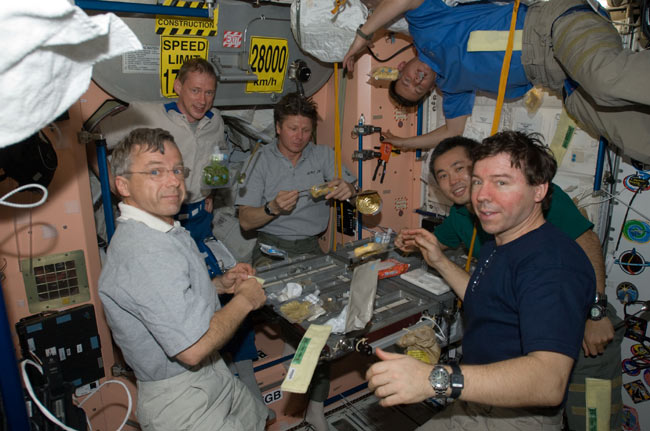Space Station Headed for Population Explosion

The fullystaffed International Space Station is about to get even more crowded when sevenshuttle astronauts join the six men already aboard, boosting the number ofpeople aboard to 13 - its highest population ever.
NASA?sshuttle Endeavour is set to launch toward the $100 billion space station Saturday morning andarrive two days later to deliver aJapanese space porch during a marathon16-day flight that includes five spacewalks.
?We?re kindof having a populationexplosion in space, you know, with the 13 or so people will be up there,? saidDave Wolf, Endeavour?s chief spacewalker, in a NASA interview. ?That will beinteresting.?
Maxingout station capacity
The spacestation has never hosted 13 people at the same time, though it has seen jointcrews of 10 during past shuttle visits. In fact, 13 has been the historicalmaximum population in orbit. But it has been typically spread acrossseveral spacecraft like the station, a shuttle and an in-bound Russian Soyuzvehicle.
?It will bechallenging, because we?ve never worked together as a crew of 13 before?ever,?Polansky said in an interview. ?So the first time we do this will be when weactually get up there, and the hatches are open.?
The stationis home to a full six-man crew - two Russian cosmonauts and one astronaut eachfrom the United States, Japan, Belgium and Canada. Together, the spaceflyersrepresent each of the station?s major international partners. Endeavour willdock at the station with six more American astronauts and another Canadianspaceflyer aboard.
Breaking space news, the latest updates on rocket launches, skywatching events and more!
Americanflight engineer Michael Barratt joined the station crew in March when onlythree people were aboard. With nine different modules, two bathrooms, twokitchens and ample exercise gear, the station is as long as afootball field and rivals a jumbo jet?s interior for living space. It can be seeneasily from Earth by the unaided eye.
?Six peoplestill don?t quite fill it,? Barratt said last week, adding that life aboardwill change once Endeavour?s crew arrives. ?It will be busy. There will be alot of coordination, a lot activity, and a lot of patience.?
The spacestation?s Russian and American air scrubbers, which clean potentially poisonouscarbon dioxide from the outpost?s living areas, cannot handle the load createdby all 13 people aboard, mission managers said. Endeavour astronauts will haveto use the shuttle?s system to make up for the difference.
At leastfour shuttle astronauts will also have to use one of the space station?s twobathrooms every day. Once Endeavour astronauts install the station?s newJapanese porch, they can?t dump the shuttle?s toilet waste overboard for fearof contaminating the brand new experiment platform.
Missionmanagers said the visiting shuttle astronauts will be free to partake of thestation?s recycled drinking water while aboard. The station crew has beendrinking the water, which is recycledfrom urine, sweat and condensation, since last month.
?The wateris great,? Barratt said. ?It?s probably as good as, or better, than anythingyou?d buy in a fancy bottle on the ground. We use it every day.?
Crowdcontrol in space
While theshuttle and spacestation astronauts are free to work out their population issues on theirown, there are some guidelines they can follow. At the top of Mission Control?slist is communication.
Imagine 13 peoplein your house, all of them performing different chores and having different questions,said Holly Ridings, NASA?s lead station flight director.
"Ifyou're the one single person in that house who can answer all of the questionssuch as one of the control centers on the ground, well, you can't all ask thosequestions at the same time,? Ridings said.
Polanskyplans to meet daily with the station?s Russian commander Gennady Padalka tomake sure both crews are on the same page and find out if, like any household onEarth, there are places on the station the shuttle astronauts shouldn?t touchwithout permission.
?In termsof just being good houseguests, every shuttle crew tries to do that,? Polanskysaid in an interview. ?Any time we have a task that requires us to use theirequipment, we will always ask them first before we just barge in there and doit.?
Polanskydoes not expect it to be easy, especially when you have 13 driven people tryingto work together.
?Sometimesone of the problems can be that everyone wants to help,? Polansky said. ?Withthe old adage of too many cooks, you could have too many people trying to helpout and do less with more.?
Carefulcommunication and focus, in space and on Earth, should clear up some of theconfusion, Polansky said, but unexpected hurdles are almost a sure bet.
?I am surethere are going to be growing pains,? Polansky said. ?There?s no doubt aboutit.?
SPACE.comwill provide complete coverage of Endeavour's STS-127 mission with staff writerClara Moskowitz in Cape Canaveral, Fla., and Senior Editor Tariq Malik in NewYork. Click here for live coverage,mission updates and a link to NASA TV.
- New Video - Meet the STS-127 Shuttle Astronauts
- New Video - Recycled Space Urine, Drink Up!
- Video Show - The ISS: Foothold on Forever

Tariq is the award-winning Editor-in-Chief of Space.com and joined the team in 2001. He covers human spaceflight, as well as skywatching and entertainment. He became Space.com's Editor-in-Chief in 2019. Before joining Space.com, Tariq was a staff reporter for The Los Angeles Times covering education and city beats in La Habra, Fullerton and Huntington Beach. He's a recipient of the 2022 Harry Kolcum Award for excellence in space reporting and the 2025 Space Pioneer Award from the National Space Society. He is an Eagle Scout and Space Camp alum with journalism degrees from the USC and NYU. You can find Tariq at Space.com and as the co-host to the This Week In Space podcast on the TWiT network. To see his latest project, you can follow Tariq on Twitter @tariqjmalik.
